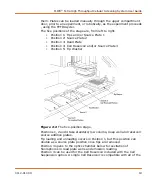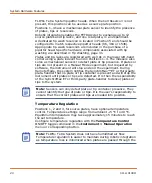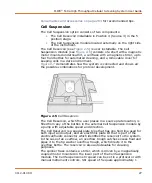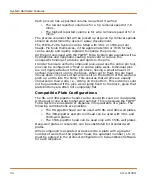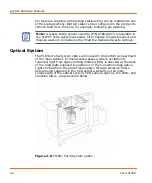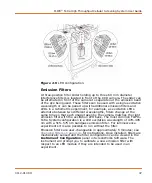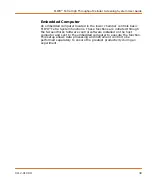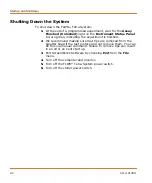
FLIPR
®
Tetra High Throughput Cellular Screening System User Guide
0112-0109 H
31
Tip and Pin Tool Loading
For all pipettor and pin tool heads, a sensor informs the software
whether or not tips or a pin tool are loaded. If desired, at the start of an
experiment, tips or a pin tool can be automatically loaded onto the
pipettor head by selecting
Load Tips Position
in the
Settings
process. Otherwise, tip and pin tool loading or unloading must be
requested as independent operations from the
Instrument > Manual
Operation
menu. Directions for installation of the 1536 tip gasket are
given in
Exchanging the 1536 Tip Gasket on page 135
Tip and pin tool loading steps can be programmed to occur between
fluid transfers within experiment protocols.
Tip and Pin Tool Washing
Tip or pin tool washing is controlled with the Wash Tips or Wash Pins
process in ScreenWorks Software protocols and can be performed
between fluid transfers within an experiment, or after the last fluid
transfer, to prepare tips for the next experiment. Disposable tips, as
well as the 1536-tip head, and 384- and 1536-pin tools, can be
washed.
The washer consists of a reservoir top of the selected pipettor format,
mounted over a wash basin. Detailed instructions for exchanging the
reservoir top are located in
Uninstalling Wash Reservoir Top on
. The wash basin is connected to two solvent-supply carboys
and two waste carboys located on the floor beneath the computer
monitor. A basin beneath the tip washer base drains to a waste carboy,
to safely remove any solvent that overflows from the reservoir.
Wash solution fills the reservoir for a calibrated amount of time. Solvent
is then drained from the reservoir after each wash cycle. Up to five
wash cycles can be configured within a single wash process. For tips, a
user-set volume of solvent is drawn up, optionally held for a time, and
then expelled, up to 20 times. For pins, vertical motion of the tip block
is used to agitate the wash solvent around the pins. The option is
available to wash tips or pins in up to two solutions before reusing the
tip washer. When additional wash solutions are required, tips or pins
can be washed in a boat or reservoir, located in one of the source plate
positions, using the
Mix Fluid
process.
WARNING! High volumes of volatile, flammable solvents in the
reading chamber may cause explosive conditions. Use of 100%
isopropanol,
etc.
, in the tip washer is particularly discouraged
without additional ventilation. Consult your facilities expert to
determine the appropriate ventilation to avoid explosive
conditions.
Summary of Contents for FLIPR Tetra
Page 1: ...FLIPR Tetra High Throughput Cellular Screening System User Guide 0112 0109 H December 2011...
Page 12: ...Contents 12 0112 0109 H...
Page 16: ...System Overview 16 0112 0109 H...
Page 40: ...System Hardware Features 40 0112 0109 H...
Page 148: ...Exchanging Hardware 148 0112 0109 H...
Page 156: ...Calibration and Signal Test 156 0112 0109 H...
Page 196: ...Running an Experiment 196 0112 0109 H...
Page 232: ...Robotic Integration 232 0112 0109 H The following drawings illustrate these requirements...
Page 282: ...Data Processing Algorithms 282 0112 0109 H...
Page 294: ...Consumables and Accessories 294 0112 0109 H...
Page 298: ...Using AquaMax Sterilant 298 0112 0109 H...
Page 302: ...Electromagnetic Compatibility EMC 302 0112 0109 H...



